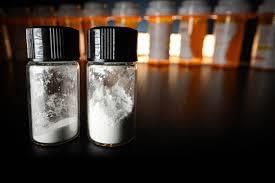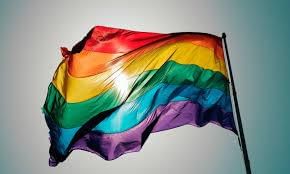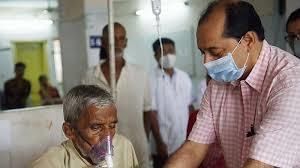Weekly Current Affairs (1st to 7th April 2024) Part - 1 | General Test Preparation for CUET UG - CUET Commerce PDF Download
| Table of contents |

|
| India’s First Small-Scale LNG Unit in Madhya Pradesh |

|
| Ketamine |

|
| Recognition of LGBTQIA+ Rights in India |

|
| SC Halts Implementation of Amended IT Rules |

|
| India TB Report 2024 |

|
India’s First Small-Scale LNG Unit in Madhya Pradesh
What is LNG and SSLNG?
- Liquefied natural gas (LNG) is essentially natural gas cooled to a liquid state, making it more convenient and secure for storage and transportation at temperatures around -260°F (-162°C). With its cleaner and more cost-effective attributes compared to conventional hydrocarbons like coal and oil, natural gas plays a pivotal role in India's transition to greener energy alternatives. It primarily comprises methane, accounting for 70-90% of its composition.
- Despite natural gas only constituting 6.7% of India's energy portfolio presently, it holds significant potential for growth. The top producers of natural gas globally include the United States, Russia, and Iran.
- SSLNG involves liquefying and transporting natural gas on a smaller scale, enabling supply to areas lacking pipeline connections through specialized trucks and vessels. This approach not only reduces reliance on expensive gas imports but also supports cleaner energy adoption, aligning with India's sustainable fuel goals.
SSLNG finds applications in various sectors:
Transportation:
- Marine Fuel: LNG is increasingly preferred for ships and vessels, particularly in emission-controlled zones, owing to lower emissions compared to traditional marine fuels.
- Road Transport: LNG serves as a cleaner fuel option for heavy-duty vehicles, offering reduced emissions of pollutants and greenhouse gases compared to diesel.
Industrial Applications:
- Power Generation: LNG is utilized in gas-fired power plants, offering a cleaner alternative to coal or oil with lower emissions.
- Heating and Cooling: LNG finds use in industrial processes for heating, cooling, refrigeration, and food processing.
Energy Storage and Backup:
- Renewable Energy Integration: LNG complements renewable sources by providing backup power during intermittency or unavailability.
- However, challenges persist, including high costs associated with facility construction and transportation, limited availability of LNG vehicles, financing hurdles, and environmental impacts such as methane emissions. Additionally, safety concerns regarding LNG's flammability necessitate proper handling and storage protocols to mitigate risks.
Way Forward
- LNG Infrastructure Development: Investing in expanding LNG import terminals and regasification facilities to increase LNG availability.
- Also, building a robust SSLNG infrastructure, including specialised trucks, vessels, and storage facilities, to reach areas without pipeline connections.
- Market Development: Creating awareness and promoting the benefits of LNG and SSLNG among industries, commercial users, and the transportation sector.
- Encouraging investment in LNG-powered vehicles and equipment, offering incentives and financing options for adoption.
- Regulatory Support: Developing clear regulatory frameworks and standards for LNG and SSLNG operations, ensuring safety, environmental compliance, and quality control.
- Investing for Innovation: Invest in R&D of advanced LNG technologies, such as cryogenic storage and transport solutions, to improve efficiency and reduce costs.
- Push for International Collaboration: At COP28, the United Nations Framework Convention on Climate Change mentioned “transitional fuels” for energy security in its outcome of the First Global Stocktake, alluding to natural gas.
- Participating in regional and global initiatives for LNG trade, infrastructure development, and policy harmonisation can strengthen India's position in the global LNG market.
Ketamine
Context: Recently, Ketamine has garnered increased attention, sparking debates and discussions regarding its usage, effects, and safety concerns.
Key Facts about Ketamine:
- Ketamine serves as a dissociative anaesthetic, utilized by medical professionals to induce general anesthesia without necessitating muscle relaxation.
- Originally developed as an animal anesthetic in the 1960s, Ketamine gained approval from the United States Food and Drug Administration (FDA) for human application.
- In contemporary times, Ketamine has been explored for treating depression and mental disorders, alongside its recreational use, which involves methods like snorting, injecting, or smoking.
- For therapeutic purposes, Ketamine is administered intravenously, through nasal spray, or as a tablet.
Effects of Ketamine:
- The mechanism of Ketamine involves blocking the N-methyl-D-aspartate (NMDA) receptor in the brain, implicated in pain signal transmission and mood regulation.
- By inhibiting the NMDA receptor, Ketamine can induce analgesia (pain relief) and euphoria, often leading to pleasant visualizations and feelings of detachment.
- Ketamine can also evoke hallucinations akin to substances like Lysergic acid diethylamide (LSD) and phencyclidine (PCP), characterized by distorted perceptions of sounds and sights.
Safety of Ketamine Consumption:
While some medical professionals consider Ketamine safe for medicinal usage, reported risks include addiction and cognitive impairment, especially in high doses. However, limited research impedes a comprehensive understanding of the long-term safety profile of the drug.
Recognition of LGBTQIA+ Rights in India
Context: The recent focus in the news revolves around the Supreme Court's caution to judges regarding the use of court-ordered counseling as a means to coerce LGBTQ+ individuals into renouncing their own identity and sexual orientation, particularly in situations where they are experiencing distress or familial separation.
- The Supreme Court emphasized the inappropriateness of attempting to alter an individual's identity and sexual orientation through counseling, even though it is acceptable to understand their desires.
Status of LGBTQIA+ Rights and Recognition in India:
- LGBTQIA+ stands for lesbian, gay, bisexual, transgender, queer, intersex, and asexual, with the "+" representing other identities that continue to emerge and be understood. This acronym is dynamic and may include terms like non-binary and pansexual.
Historical Recognition of LGBTQIA+ in India:
Colonial Era and Stigma (Pre-1990s):
- 1861: Section 377 of the Indian Penal Code criminalizes "carnal intercourse against the order of nature," creating significant barriers for LGBTQIA+ rights.
Early Recognition and Activism (1990s):
- 1981: The inaugural All-India Hijra Conference occurred.
- 1991: The AIDS Bhedbhav Virodhi Andolan (ABVA) releases "Less Than Gay," the first public report advocating for legal reforms for LGBTQIA+ individuals.
Landmark Cases and Setbacks (2000s):
- 2001: The Naz Foundation files a Public Interest Litigation (PIL) challenging Section 377.
- 2009: A landmark ruling by the Delhi High Court in Naz Foundation vs Govt of NCT of Delhi decriminalizes consensual homosexual acts, marking a significant victory for LGBTQIA+ rights.
- 2013: The Supreme Court overturns the Delhi High Court decision, upholding Section 377, a setback for LGBTQIA+ rights.
Recent Advancements and Ongoing Struggle (2010s-Present):
- 2014: The Supreme Court recognizes transgender people as a "third gender" in the NALSA judgment.
- 2018: A historic decision by the Supreme Court strikes down Section 377, decriminalizing same-sex relationships in Navtej Singh Johar v. Union of India.
- 2019: The Transgender Persons (Protection of Rights) Act, 2019 is passed, providing legal recognition and prohibiting discrimination against transgender individuals.
- 2020: The Uttarakhand High Court acknowledges legal protection for same-sex couples in live-in relationships.
- 2021: The Bombay High Court upholds the right to self-identify gender, ruling in favor of a transgender petitioner in Anjali Guru Sanjana Jaan v. State of Maharashtra & Ors.
- 2022: The Supreme Court expands the definition of family to include same-sex couples and queer relationships.
- 2023: A five-judge Constitution Bench of the Supreme Court rejects petitions to legalize same-sex marriage, stating that the authority to amend laws like the Special Marriage Act lies with Parliament and state legislatures.
What are the Major Challenges Faced by LGBTQIA+ in India?
- Social Stigma: Deep-rooted societal attitudes and stigma against LGBTQIA+ individuals persist in many parts of India.
- This leads to prejudice, harassment, bullying, and violence in different social arenas like education and employment affecting the mental and emotional well-being of LGBTQIA+ individuals.
- Family Rejection: Many LGBTQIA+ individuals experience rejection and discrimination within their families, leading to strained relationships, homelessness, and a lack of support systems.
- Healthcare Access: They often encounter barriers to accessing healthcare services, including discrimination from healthcare providers, lack of LGBTQIA+-friendly healthcare facilities, and challenges in obtaining appropriate medical care related to sexual health.
- Inadequate Legal Recognition: While progress has been made in recognizing transgender rights, there is still a lack of legal recognition and protections for non-binary and gender non-conforming individuals.
- Legal challenges related to marriage, adoption, inheritance, and other civil rights persist for them.
- Intersectional Challenges: LGBTQIA+ individuals who belong to marginalized communities, such as Dalits, tribal communities, religious minorities, or those with disabilities, face compounded discrimination and marginalization based on their intersecting identities.
- Manipulative Counseling: Manipulative counseling practices, such as conversion therapy and pathologizing LGBTQIA+ identities, exacerbate the challenges faced by this community.
- These practices reinforce harmful stereotypes, deny authenticity, and contribute to internalized stigma and distress.
Way Forward
- Push for Legal Reforms: In 2023, the SC judgment on LGBTQIA+ marriages transferred the ball in the legislature’s court to make relevant laws for the community.
- Legislatures can pass a separate law altogether or make amendments in the existing laws to recognise their rights.
- For example, Tamil Nadu has already amended the Hindu Marriage Act in 1968 to allow self-respect or ‘Suyamariyathai’ marriages which allowed marriages to be declared in the presence of the couple’s friends or family or any other persons.
- Entrepreneurship and Economic Empowerment: Encouraging entrepreneurship and economic empowerment within the LGBTQIA+ community by providing them access to mentorship, funding, and resources for starting LGBTQIA+-owned businesses and ventures.
- Promote LGBTQIA+-friendly workplaces and businesses through certification programs.
- Healthcare Access: Ensuring access to LGBTQIA+-friendly healthcare services, including mental health support, gender-affirming care, HIV/AIDS prevention and treatment, and sexual and reproductive health services.
- Training healthcare providers to provide culturally competent and inclusive care to LGBTQIA+ patients.
- Sports as a Game Changer: Sports can be used as a platform for breaking stereotypes and fostering camaraderie.
- Creating sports leagues specifically designed for LGBTQIA+ individuals to promote physical health, mental well-being, and community bonding can be done in this regard.
SC Halts Implementation of Amended IT Rules
Context: Recent news highlights the Supreme Court of India's decision to temporarily halt the implementation of the central government's Fact Check Unit (FCU), following an appeal filed in the Bombay High Court challenging the amended Information Technology (IT) Rules of 2023. These rules empower the government to identify fake news circulating on social media platforms.
- The Fact Checking Unit (FCU), established as a statutory body under the Press Information Bureau (PIB) by an amendment to the Information Technology (Intermediary Guidelines and Digital Media Ethics Code) Rules in 2023, is tasked with identifying and flagging content deemed false related to the central government and its agencies on social media platforms.
What is the Fact Checking Unit and Amended IT Rules 2023?
- Key provisions of the amended IT Rules of 2023 concerning fake news require online intermediaries, including social media platforms like Facebook, YouTube, and Twitter, as well as internet service providers like Airtel, Jio, and Vodafone Idea, to ensure they do not disseminate inaccurate information about the Government of India.
- Furthermore, these platforms are obligated to make reasonable efforts to avoid hosting content related to the Central Government identified as false or misleading by a fact-checking unit. Failure to comply could result in the loss of their safe harbor protection, shielding them from legal action regarding third-party content.
What are the Major Concerns Related to the Amended IT Rules, 2023?
- Potential Arbitrary Enforcement: There are concerns about the arbitrary nature of how the FCU determines what constitutes false information related to the central government.
- This could lead to subjective judgments and selective targeting of certain viewpoints or individuals.
- Critics argue that these rules specifically the amendment to Rule 3(1)(b)(v) of the IT Rules 2021 as being violative of Article 14, Article 19(1)(a) and (g), Article 21 of the Constitution.
- The Supreme Court in Shreya Singhal vs Union of India (2015), held that a law that limits speech can neither be vague nor over-broad.
- The amendment to Rule 3(1)(b)(v) of the IT Rules 2021 expanded the definition of "fake news" to include fake news involving government business which can lead to potential arbitrary enforcement.
- Impact on Intermediaries: The rules place significant responsibilities on online intermediaries to monitor and remove content flagged by the FCU.
- This could create a burden for these intermediaries and potentially lead to over-censorship to avoid legal repercussions.
- Potential for Misuse: There are concerns that these rules could be misused by the government to suppress dissenting opinions or criticism, particularly against government policies or officials.
- The lack of robust safeguards against such misuse raises apprehensions about the rules' overall impact on democratic discourse and transparency.
Way Forward
- Ensuring Transparency and Accountability: The government should ensure transparency in the operations of the FCU, including clearly defining the criteria and procedures used to identify false information.
- Additionally, mechanisms for oversight and accountability should be established to prevent misuse or arbitrary enforcement.
- Clear Guidelines and Due Process: Developing clear guidelines and due process mechanisms for intermediaries to follow when dealing with content flagged by the FCU.
- This includes providing avenues for content creators to appeal decisions and ensuring that removals are based on objective criteria and evidence.
- Legal Safeguards: Ensure that any regulatory measures comply with constitutional principles and international human rights standards, particularly regarding freedom of speech and expression.
- Legal safeguards should be in place to prevent overreach and protect individuals' rights to express diverse opinions.
India TB Report 2024
Context: Recently, the Ministry of Health and Family Welfare unveiled the India TB Report 2024, which indicates a decline in the mortality rate due to Tuberculosis (TB) from 28 per lakh population in 2015 to 23 per lakh population in 2022.
Key Highlights of the Report:
Trends in TB Cases and Deaths:
- Government health centers continue to report the majority of TB cases, although there has been an increase in notifications from the private sector.
- Approximately 33% or 8.4 lakh of the 25.5 lakh cases reported in 2023 originated from the private sector, contrasting with 1.9 lakh cases reported by the private sector in 2015, which serves as the baseline year for the elimination program.
- The estimated TB incidence in 2023 slightly rose to 27.8 lakh from the previous year's estimate of 27.4 lakh, while mortality remained steady at 3.2 lakh.
- India's TB mortality dropped from 4.94 lakhs in 2021 to 3.31 lakhs in 2022.
- India achieved its 2023 target of initiating treatment in 95% of diagnosed TB patients.
Challenges in Meeting Targets:
- Despite setting ambitious goals to eliminate TB by 2025, India has encountered difficulties in achieving these targets.
- The number of cases and deaths recorded in 2023 fell short of the country's set targets.
- Various risk factors, including undernourishment, HIV, diabetes, alcohol use, and smoking, contribute to TB incidence and treatment outcomes.
Undernourishment:
- Nearly 7.44 lakh TB patients were undernourished in 2022, prompting government initiatives such as providing monthly support and implementing the Ni-kshay Mitra program.
HIV:
- Approximately 94,000 TB patients in 2022 were living with HIV, who face a significantly higher risk of TB symptoms compared to the general population.
Diabetes:
- An estimated 1.02 lakh TB patients in India had diabetes in 2022, exacerbating the risk of Multi-Drug Resistant TB and hindering TB treatment efficacy.
Alcohol and Tobacco Use:
- Alcohol consumption exceeding 50 ml per day increases the risk of TB infection, with around 18.8 lakh TB patients screened for alcohol use and 19.1 lakh screened for tobacco use in 2023. Subsequent linkage to cessation services was emphasized, with 32% of tobacco users seeking support.
What is Tuberculosis?
About:
- Tuberculosis is a bacterial infection caused by Mycobacterium tuberculosis. It can practically affect any organ of the body. The most common ones are the lungs, pleura (lining around the lungs), lymph nodes, intestines, spine, and brain.
Transmission:
- It is an airborne infection that spreads through close contact with the infected, especially in densely populated spaces with poor ventilation.
Symptoms:
- Common symptoms of active lung TB are cough with sputum and blood at times, chest pains, weakness, weight loss, fever and night sweats.
Infection Prevalence:
- Every year, 10 million people fall ill with TB. Despite being a preventable and curable disease, 1.5 million people die from TB each year – making it the world’s top infectious killer.
- TB is the leading cause of death of people with HIV and also a major contributor to antimicrobial resistance.
- Most of the people who fall ill with TB live in low- and middle-income countries, but TB is present all over the world. About half of all people with TB can be found in 8 countries: Bangladesh, China, India, Indonesia, Nigeria, Pakistan, Philippines and South Africa.
Treatment:
- TB is treated with a standard 6-month course of 4 antimicrobial drugs that are provided with information, supervision and support to the patient by a health worker or trained volunteer.
- Anti-TB medicines have been used for decades and strains that are resistant to 1 or more of the medicines have been documented in every country surveyed.
- Multidrug-resistant Tuberculosis (MDR-TB) is a form of TB caused by bacteria that do not respond to isoniazid and rifampicin, the 2 most powerful, first-line anti-TB drugs.
- MDR-TB is treatable and curable by using second-line drugs such as bedaquiline.
- Extensively drug-resistant TB (XDR-TB) is a more serious form of MDR-TB caused by bacteria that do not respond to the most effective second-line anti-TB drugs, often leaving patients without any further treatment options.
- Drugs for TB:
- Isoniazid (INH): This drug is a cornerstone of TB treatment and is highly effective against Mycobacterium tuberculosis.
- It works by inhibiting the synthesis of mycolic acids in the bacterial cell wall.
- Rifampicin (RIF): Another essential drug in TB treatment, rifampicin works by inhibiting the synthesis of RNA in the bacteria.
- It is often used in combination with other drugs to treat TB and is crucial for preventing the development of drug resistance.
- Delamanid: Delamanid is a newer drug that is used in the treatment of multidrug-resistant TB (MDR-TB) and is often used in combination with other drugs.
Conclusion
The path to TB elimination in India requires a concerted effort to prioritise person-centred care, address social determinants of health, and embrace innovation. By adopting a holistic and person-centred approach, India can overcome the barriers that stand in the way of TB control and create a healthier future for all its citizens.
|
164 videos|626 docs|1128 tests
|

























